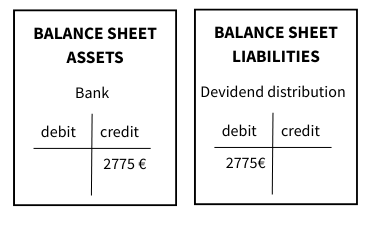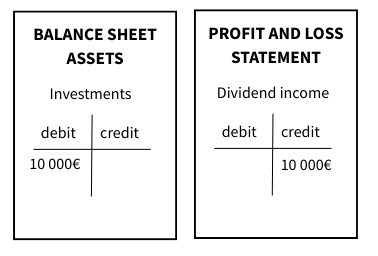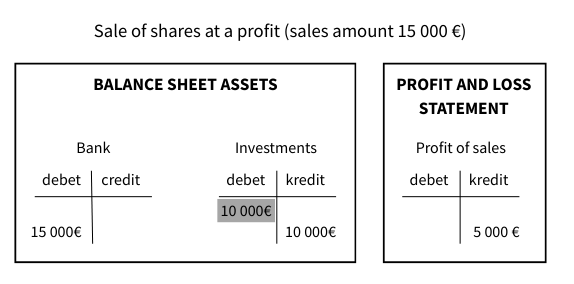Dividends in accounting – how to record income and distributions? (0)
Dividends in accounting are recorded using the same principles as any other accounting entry. If a company receives dividends, they are considered income, and income increases on the credit side. If a company distributes dividends, they can be thought of as expenses, which belong on the debit side.
In accounting, dividends are recorded in the financial year during which the underlying financial statements are approved and the decision to distribute dividends is made. For example, in 2022 dividends are distributed based on the 2021 financial statements, and once the general meeting has decided on the distribution, the dividends can be recorded in 2022.
Payment of dividends
It makes no difference whether dividends are paid to the entrepreneur personally or to someone else – in accounting, dividends behave exactly the same way.Receiving dividends in cash
A company can receive dividends either in cash or in another form, such as shares. If the company receives dividend income in cash, dividends are treated like any other income. They are recorded as a debit to the bank account on the balance sheet and a credit entry is made to the dividend income on the proft and loss statement. In SimplBooks, the entry would look like this:
Receiving dividends in shares
Sometimes dividends are paid in the form of shares and their accounting treatment depends on whether the recipient engages in securities trading. If the company does not engage in securities trading, the shares are recorded under investments in fixed assets on the balance sheet and under dividend income on the profit and loss statement. If the company engages in securities trading, the recording is slightly different and must be done in two parts.
Shares are assigned a fair value at the time the dividend becomes available and this is the value used for both the dividend income entry and the balance sheet entry. It’s important to note that a company receiving shares as dividends is liable for transfer tax on those shares, and the tax paid becomes part of the acquisition cost of the shares (i.e., the value at which the asset is recorded).
Dividends in shares without securities trading
If a company receives shares as dividends and does not engage in securities trading, the shares are recorded under fixed assets investments on the balance sheet and dividend income in the profit and loss statement.
If the shares are later sold, the entry is a debit to the bank account and a credit to fixed asset investments. In this way, the investments account is cleared with respect to those shares and they are no longer in the accounting records.
Usually, shares are sold at a different price than they were acquired for, and depending on this, the sales price of the shares will result in either a gain or a loss on sale, which must be taken into account when recording the transaction.
Dividends in the form of shares and securities trading
If a company engages in securities trading and receives shares as dividends, the entry is slightly different. The final placement of the shares in the accounting records is inventory, but they cannot be recorded directly there, because the corresponding account can only be the inventory change account. The entry must therefore be made in two parts.
|
EXAMPLE First entry
Second entry:
💡So the final destination of dividend income is inventory, but since it cannot be recorded directly there, it has to be taken through purchases and inventory changes. Inventory changes affect the amount of purchases by either increasing or decreasing it. In this case, the entries for purchases and inventory changes “cancel” each other out – meaning the dividend entry has no effect on the income statement at all. |
|
EXAMPLE If the shares in the example are sold, the sale is also recorded in two parts. The sale is revenue for the company. First entry The entry is made at the selling price of the shares.
Second entry: The entry is made at the acquisition price of the share.
|
If a company engages in securities trading and sells its owned shares, no separate capital gain (or loss) arises, because the sale is always recorded directly as revenue.
Dividends in accounting are not more complicated than any other income or expense. Receiving dividend income in the form of shares can cause some confusion, whether securities trading is conducted or not. But it is manageable as long as one takes the time to properly understand the subject. With the rule of thumb that income increases on the credit side and expenses on the debit side, one can already go a long way — even in this matter!
Try right away!
A more advanced and easy accounting software SimplBooks with over 10,000 active users - register an account and you can try 30 days free of charge and risk-free (no financial obligations shall arise). Or try our demo version!











Leave a Reply